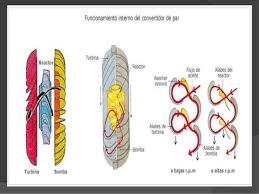TRANSMISIONES AUTOMATICAS
Louis-Rene Panhard, a French engineer and the Sturtevant brothers, American inventors dedicated to the agricultural industry, are the first to attempt to create automatic transmissions. Panhard founded in 1890 the foundations of the Daimler group, while the American brothers limited themselves in 1904 to their local application and demonstrations, where he was known as "cart without horses" to his invention. Let's say of the first component of a transmission as is the converter, the main job of this piece is to transmit the force of the engine to the working train of the transmission. (We'll touch on that later)
Converter parts: impeller or also called pump, stator, spacers, turbine.
Operation of the converter: we are going to place an example, it is like having two fans one connected to the current and the other without electric power. By bringing the fan without power to the fan turned on, it will start to spin fast the closer they come. And therefore to move it away from turning. Instead of having fans we have the (impeller and turbine). Instead of zooming in and out we have the (stator) and instead of air we have the oil.
When the oil enters the converter it does it this way: it enters through the impeller blades, passes through the outside of the stator and reaches the turbine blades, the turbine returns the oil inside the stator and repeats the cycle. here the so-called famous whirlwind is generated.
Faults that can be generated by the converter to the automatic transmission: # when the vehicle is neutralized and there is garbage in the crankcase. # When there is a strong vibration in the vehicle it is a great possibility that the converter is damaged # difficulty when climbing or climbing in reverse and also when feeling the forced vehicle in plane. # This fault  recommended to change the converter as it is damaged.
recommended to change the converter as it is damaged..jpg)
.jpg)
